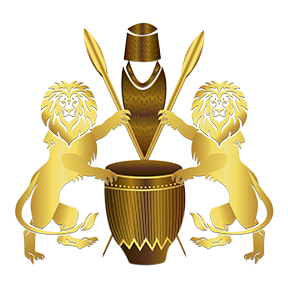The Attire
In the olden times, both men and women wore leaves to cover their private body areas. Whereas the men covered their hip area, for the women, it was the hip and breast areas.
With time, the leaves were substituted for animal skin, locally referred to as “enkanda”. The enkanda was prepared by sun drying the skin of a young cow and/or goat; thereafter, using volcanic stones locally called “ebikenkya” to rub the dried skin till it became soft. After, they trimmed it to fit.
In the later years, the enkanda was substituted with back cloth. This is a fabric woven from the inner bark of the Mutuba tree (Ficus natalensis). It is harvested during the wet season and then, in a long and strenuous process, beaten with different types of wooden mallets to give it a soft and fine texture and, an even terracotta color. This process is done in an open shed to protect the bark from drying out too quickly. It is important to not here that the back cloth was also used as a blanket and bedsheets.
With the coming of the white man, malekani was adopted. This is a plain cotton garment. From the malekani, the people were able to make shirts and trousers for the males and dresses for the females. Also, the first suuka is said to have been made from the malekani fabric.
How and when did we shift from malekani dresses to the suuka? CONTENT NEEDED
The official traditional wear for every female Mutooro is called a “Suuka”.
This consists of four (4) pieces: –
- Ekutiya – in the olden days, they wore an enkanda (dried and trimmed goat and/or cow skin). Today however, many have substituted this for a skirt made out of cotton cloth. The ekutiya is meant to prevent the ekitambi from sticking on the wearers’ body. It also helps the ekitambi open out properly.
- Ekitambi – this is a light cotton, shimmery cloth won on top of the ekutiya. It is often red with yellow and black stripes. It is also handwoven.
- Ekiteteyi kya ekifuba – this is the ‘dress’. In the olden days, the design was similar: a knee length dress with elbow reaching sleeves. However today, this name has been dropped because of the many designs.
- Esuuka – this is the wrap. There is a myth that the esuuka is so because of the cold weather in Toro region. This fabric is usually two and a half meters long.
Traditionally, the wrap and dress were made from the same material; and had tiny patterns or flowers on them. Whereas some preferred to use cotton, especially the older persons, others prefer softer materials like satin and silk especially because of its elegance, simplicity and easy maintenance.
The Suuka is adorned with enkwanzi (pearl jewelry). There are three (3) types: –
- Enkwanzi za ebikya – this is the necklace. It won in the neck and by all ages while wearing the Suuka.
- Enkwanzi za emikono – this is a pearl necklace won on each arm. It is also won by all ages.
- Enkwanzi za amaguru – called amakoito, is the pearl necklace won on each leg. They are only worn by married women.
This attire is meant to give her a sense of belonging while preserving the culture.
The traditional wear of the men is a white colored ankle or floor length garment robe called a kanzu. It has a maroon embroidery around the collar, abdomen, and sleeves. The embroidery is called the omulela. Before, it was made from the malekani material but today, it is cotton. Others have even got it made in silk and satin.
It is won with a suit jacket or blazer. The tunic commands respect from the wearer.

NEED PICTURES FOR EACH OF THE ITEMS DESCRIBED
